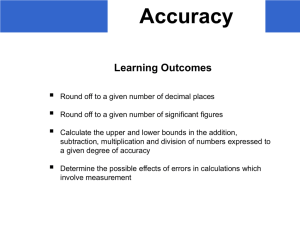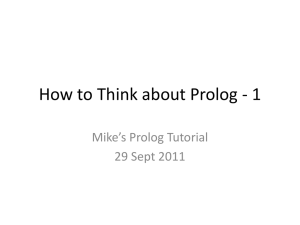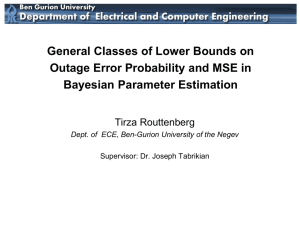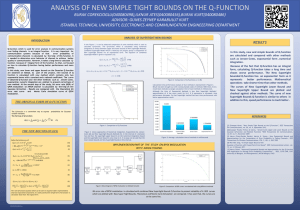Oshman
advertisement
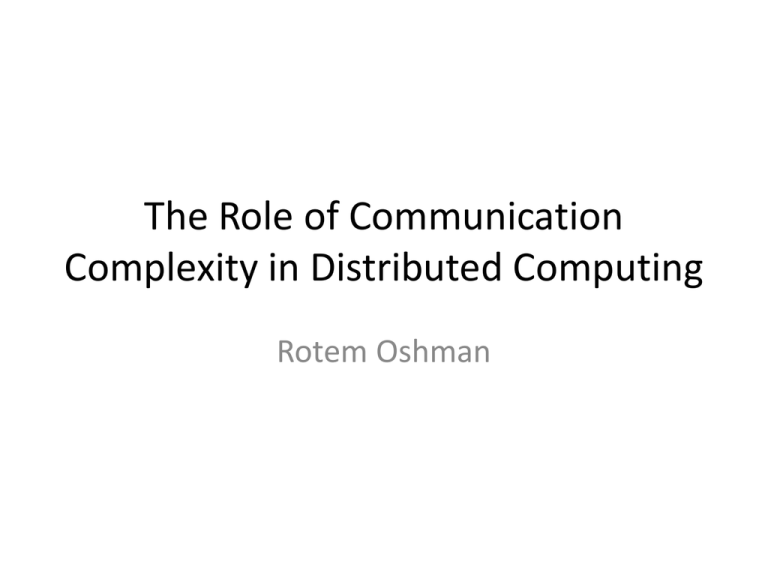
The Role of Communication Complexity in Distributed Computing Rotem Oshman Background: Distributed Computing Distributed Computing • Typical model: – Local computation for free – Charge for “communication” Distributed Lower Bounds • “All or nothing”: – If 𝑝, 𝑞 have not communicated, they know nothing about each other – If 𝑝, 𝑞 communicated, they know everything about each other • Recently: interest in quantifying the amount of communication • Natural to use communication complexity Shared Memory • Processes communicate by accessing objects in shared memory – Read/write registers – Read-modify-write: CAS, T&S, … • Typically asynchronous: – Schedule = sequence of process IDs – Adversarially chosen – Sometimes processes may crash Shared Memory Lower Bounds • “Covering arguments” • Examples: – Deterministic consensus impossible if one process may fail [FLP’79] – Mutual exclusion requires 𝑛 shared registers [BL’90] • Can we introduce a cell-probe-like model for shared memory lower bounds? Message Passing • Processes communicate by sending messages – Over some network graph, often complete • Fully synchronous, fully asynchronous, or anywhere in between • Processes can crash, recover, cheat, lie,… • Many successful applications of CC Some differences… Distributed Computing Complexity #rounds (limited bandwidth) measure Comm. Complexity total #bits Problems Search Decision Input Number-In-Hand Number-onForehead (usually) Message-Passing Models #rounds total CC LOCAL SHARED BLACKBOARD CONGEST MESSAGE-PASSING Talk Overview I. Lower bound techniques a. CONGEST (#rounds): reductions from 2-party communication complexity b. Total CC with private channels II. Shared blackboard a. Number-in-hand b. “Not-quite-number-in-hand” The CONGEST Model • 𝑛 nodes communicate over a network graph (small diameter) • Computation proceeds in synchronous rounds • Each message = 𝐵 bits • Several variants: – Communication by unicast vs. local broadcast – Arbitrary graph vs. complete graph The CONGEST Model • Arbitrary graph topology: strong lower bounds – [Distributed Verification and Hardness of Distributed Approximation, by Das Sarma, Holzer, Kor, Korman, Nanongkai, Pandurangan, Peleg, Wattenhofer] • Nearly-tight lower bound on MST approximation • Non-tight lower bounds on all-pairs shortest path, minimum cut, shortest s-t path, … • Almost all lower bounds ≤ Ω 𝑛/𝐵 – Very few Ω 𝑛/𝐵 bounds known, no super-linear bounds The CONGEST Model • Complete graph topology, unicast: – Known to be extremely powerful, e.g., • Sort 𝑛2 values in 𝑂 log log 𝑛 rounds • MST construction in 𝑂 log ∗ 𝑛 rounds – No explicit super-constant lower bound known – [Drucker, Kuhn, O. ‘14]: even slightly superconstant lower bound ⇒ new ACC lower bound • Complete graph topology, broadcast = shared blackboard CONGEST Lower Bounds for Arbitrary Graphs … by reduction from 2-party disjointness 2-Party Reductions • Textbook reduction [Kushilevitz Nisan]: Given algorithm 𝐴 for solving task 𝑇… 𝑋 𝑌 Simulate 𝐴 Based on 𝑋 𝑛 bits Based on 𝑌 Solution for 𝑇 ⇨ answer for, e.g., Disjointness 2-Party Reductions • More generally: Given algorithm 𝐴 for solving task 𝑇… 𝑌 𝑋 Based on 𝑋 Based on 𝑌 Solution for 𝑇 ⇨ answer for, e.g., Disjointness Multi-Player NIH Communication with Private Channels The Message-Passing Model • • • • 𝑘 players Private channels Private 𝑛-bit inputs 𝑋1 , … , 𝑋𝑘 Private randomness • Goal: compute 𝑓 𝑋1 , … , 𝑋𝑘 • Cost: total communication The Coordinator Model • 𝑘 players, one coordinator • The coordinator has no input Message-Passing vs. Coordinator ≈ Secure multi-party computation! Message-Passing Lower Bounds For 𝑘 players with 𝑛-bit inputs… • Woodruff, Zhang ‘12: 𝐹𝑝 estimation • Phillips, Verbin, Zhang ’12: – Ω 𝑘𝑛 for bitwise problems (AND/OR, MAJ, …) • Woodruff, Zhang ‘13: – Ω 𝑘𝑛 for threshold and graph problems • Braverman, Ellen, O., Pitassi, Vaikuntanathan ‘13: Ω 𝑘𝑛 for disjointness Symmetrization [Phillips, Verbin, Zhang ’12] Lower bound for 𝑘-player problem 𝑃𝑘 : • Choose hard 2-player problem 𝑃2 • Fix hard distribution 𝜇2 for 𝑃2 , let 𝑋, 𝑌 ∼ 𝜇2 Bob: 𝑌 “Smear” 𝑌 across 𝑘 − 1 players Alice: 𝑋 Symmetrization [Phillips, Verbin, Zhang ’12] Lower bound for 𝑘-player problem 𝑃𝑘 : Bob: 𝑌 “Smear” 𝑌 across 𝑘 − 1 players Alice: 𝑋 – 𝑘-player distribution must be symmetric – Answer to 𝑃𝑘 ⇒ answer to 𝑃2 2 𝑘 𝔼[ cost for 𝑃2 ] = ⋅ cost for 𝑃𝑘 Symmetrization Example: Bitwise-XOR • 2-party problem: – Input: uniform independent 𝑋, 𝑌 ∈ 0,1 – Goal: Alice outputs Bob’s input, 𝑌 𝑛 • Reduction: – Sample uniform 𝑖 ∈ 𝑘 , Alice sets 𝑋𝑖 = 𝑋 – Bob chooses 𝑋−𝑖 uniformly s.t. ⊕𝑗≠𝑖 𝑋𝑗 = 𝑌 – From ⊕𝑘ℓ=1 𝑋ℓ , Alice can reconstruct 𝑌 Bob: 𝑌 Alice: 𝑋 Set Disjointness 𝑋2 𝑋1 𝑋3 ? 𝑋5 𝑋4 𝑛 𝑘 𝑗 𝑋𝑖 DIS J 𝑛,𝑘 = 𝑖=1 𝑗=1 Symmetrization vs. Disjointness • Consider any symmetric distribution… Bob: 𝑌 Alice: 𝑋 • How many 0s in coord. 𝑗, given 𝑗 𝑘 𝑖=1 𝑋𝑖 = 0? – More than one ⇒ Bob probably sees a zero • Ignore this coordinate – Only one ⇒ Pr[ Alice got it ] ≈ – 2-party CC ≤ 𝑂 𝑛 log 𝑛 𝑘 1 𝑘 [BEOPV’13] Lower Bound Outline 𝑛 𝑘 𝑗 𝑋𝑖 DIS J 𝑛,𝑘 = 𝑖=1 𝑗=1 1. Direct sum: DIS J 𝑛,𝑘 ≥ 𝑛 ⋅ AND𝑘 2. One-bit lower bound: AND𝑘 ≥ Ω 𝑘 Reduction from DISJ to graph connectivity [Based on WZ’13] (Players) 𝑝1 𝑋𝑖 1 (Elements) 2 𝑝2 3 4 𝑝𝑘 input graph connected ⇔ ⋃𝑋𝑖 = 𝑛 ⇔ ⋂𝑋𝑖 = ∅ 5 6 𝑛 ∖ ⋃𝑋𝑖 Number-In-Hand Shared Blackboard Why Should We Care? • Some fundamental question still open • Natural model for distributed computing – Single-hop wireless network – More generally, abstracts away network topology – Related to MapReduce, etc. [Hegeman and Pemmaraju’14] Example: NIH Multi-Party Disjointness • Trivial upper bound: 𝑂 𝑛𝑘 – Also easy to get 𝑂 𝑛 log 𝑛 + 𝑘 • Simultaneous CC: Ω 𝑛𝑘 [Braverman,Ellen,O.,Pitassi,Vaikuntanathan’13] – In 𝑟 rounds? – Looks like for 𝑘 = 𝑛, Ω 𝑟 1+1/2 𝑛 [current work with Ran Raz] • Unbounded rounds: Θ 𝑛 log 𝑘 Braverman] [with Mark “Not-Quite Number in Hand” • In undirected networks, each edge is known to both endpoints • Distributed graph property testing: – Players 1, … , 𝑛, input graph 𝐺 = 𝑛 , 𝐸 – Input to player 𝑖: its neighbors in 𝐺 – Goal: test if 𝐺 satisfies property 𝑃 • Example: subgraph detection [Drucker, Kuhn, O. ‘14] Example: Lower Bound for 𝐶5 • Claim: 𝑅-round algorithm for 𝐶5 detection ⇒ solve DISJ𝑛2 in 𝑂 𝑅 ⋅ 𝑛 ⋅ 𝐵 bits • Reduction outline: – Alice and Bob get inputs 𝑋, 𝑌 ⊆ 𝑛 × 𝑛 – Construct input graph 𝐺 on 5𝑛 nodes, such that 𝐺 contains 𝐶5 ⇔ 𝑋 ∩ 𝑌 ≠ ∅ – Simulate the run of 𝐶5 -detection algorithm on 𝐺 Construction of 𝐺 from 𝑋, 𝑌 1 1 2 2 3 3 4 4 1 1 2 2 3 3 4 4 Construction of 𝐺 from 𝑋, 𝑌 1 1 2 2 3 3 4 4 Top-bottom: 𝒊, 𝒋 ∈ 𝑿 Bottom-top: 𝒋, 𝒊 ∈ 𝒀 1 1 2 2 3 3 4 4 Construction of 𝐺 from 𝑋, 𝑌 1 1 2 2 3 3 4 4 𝟐, 𝟒 ∈ 𝑿 ∩ 𝒀 1 1 2 2 3 3 4 4 Simulating the Algorithm • Alice simulates 3𝑛 nodes, Bob simulates 2𝑛 • To simulate one round, each player: – Locally computes message broadcast by each node it simulates – Sends all messages to the other player – Cost: 𝑂 𝑛 ⋅ 𝐵 per round • Total cost: 𝑂 𝑅𝑛𝐵 ⇒𝑅=Ω 𝑛 𝐵 What About 𝐶4 ? • More complicated…. Can contain 𝐶4 regardless of 𝑋 Solution: use extremal 𝐶4 -free graph 𝐹 Elements of DISJ = edges of 𝐹 Upper Bound on Subgraph Detection • Turán number: 𝑒𝑥 𝐻, 𝑛 = max # edges in 𝐻free graph on 𝑛 vertices • Upper bound: solve 𝐻-subgraph detection in 𝑂 𝑒𝑥 𝐻,𝑛 𝑛𝐵 rounds – Example: 𝑒𝑥 𝐶5 , 𝑛 = 𝑛2 /4, nearly tight – Open problem: is this tight for all subgraphs? Detecting Triangles • Trivial upper bound: 𝑂 𝑛 𝐵 rounds • Lower bound? – 2-party (black box) reduction cannot prove it – For each triangle, one player knows all 3 edges Triangles to 3-Party NOF Disjointness • [Ruzsa and Szemerédi ’76]: there is a tripartite graph 𝐺 = (𝐴 ∪ 𝐵 ∪ 𝐶, 𝐸) where – 𝐴 = 𝐵 = 𝑛, 𝐶 = 𝑛/2 – 𝐺 contains T = 𝑛2 /𝑒 𝑂 log 𝑛 triangles – Each edge in 𝐸 belongs to exactly one triangle • Reduce from 3-party NOF Disjointness on 𝑇 elements, each representing one triangle in 𝐺 Triangles to 3-Party NOF Disjointness • Input: sets of triangles 𝑋, 𝑌, 𝑍 ⊆ 𝑇 𝑍 • Let 𝑡(𝑒) be the unique triangle edge 𝑒 belongs to • Construct 𝐺 ′ ⊆ 𝐺, including: 𝐶 – 𝑒 ∈ 𝐴 × 𝐵 iff 𝑡 𝑒 ∈ 𝑍 – 𝑒 ∈ 𝐵 × 𝐶 iff 𝑡 𝑒 ∈ X – 𝑒 ∈ 𝐴 × 𝐶 iff 𝑡 𝑒 ∈ 𝑌 • Note: endpoints of each edge agree on its inclusion! 𝑋 𝑌 𝐴 𝐵 Triangles to 3-Party NOF Disjointness • Input: sets of triangles 𝑋, 𝑌, 𝑍 ⊆ 𝑇 • Triangle appears in 𝐺 ′ ⇔ 𝑋 ∩ 𝑌 ∩ 𝑍 ≠ ∅ • Cost of simulation: 𝑍 𝐶 𝑋 – 𝑂(𝑛𝐵) bits per round ⇒ Round complexity of triangle detection ≥ 𝐶𝐶(DIS J 𝑇 )/(𝑛𝐵) for 3-party NOF 𝑌 𝐴 𝐵 3-Party NOF Disjointness • Randomized CC: – Sherstov’13: Ω – We get nothing: #elements 𝑇 𝑛𝑏 <1 • Deterministic CC: – Rao and Yehudayoff’14: Ω #elements ⇒Ω 𝑛 𝐵⋅𝑒 𝑂 detection log 𝑛 for deterministic triangle Conclusion #rounds total CC LOCAL SHARED BLACKBOARD CONGEST MESSAGE-PASSING Directions for Future Research • Exploiting asynchrony and faults to get stronger communication lower bounds Example 1: Dynamic Networks • Abstract model for dynamic networks: – In each round 𝑟 we get a different graph 𝐺 𝑟 • [Kuhn, Lynch, O. ‘10]: – Assume each 𝐺 𝑟 is connected – Any function can be deterministically computed in 𝑂 𝑛2 rounds using 𝑂 log 𝑛 -bit messages – Lower bounds? Example 1: Dynamic Networks • For exchanging all inputs: – Determistic, “routing-based” algorithms: Ω [Haeupler, Kuhn’12] – Randomized?? – Non-routing based?? 𝑛2 log 𝑛 Example 2: Byzantine Consensus • 𝑛 processes, synchronous message-passing • Each process receives a bit • Goal: – Everyone outputs the same bit – If everyone received 𝑏, the output is 𝑏 𝑛 3 • Byzantine faults: up to − 𝜖 processes may behave arbitrarily Example 2: Byzantine Consensus • [King, Saia ‘10]: can solve with 𝑂(𝑛3/2 ) total bits • No general lower bound better than Ω 𝑛
